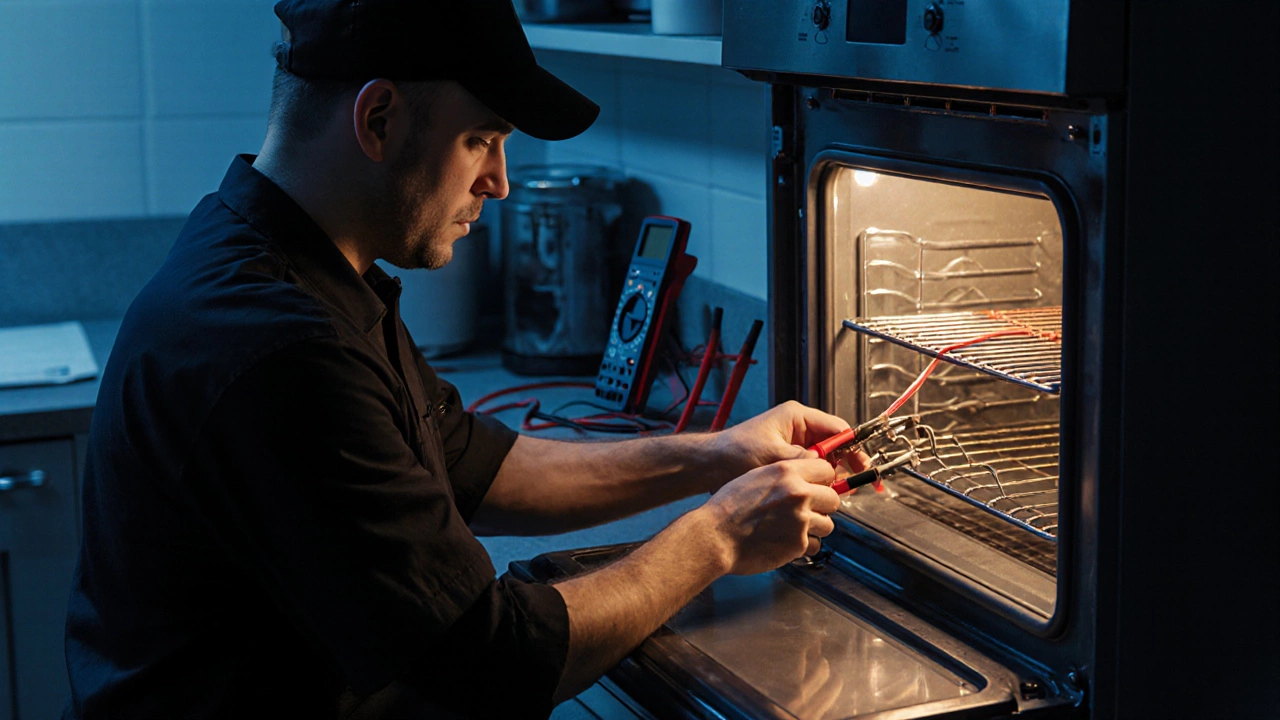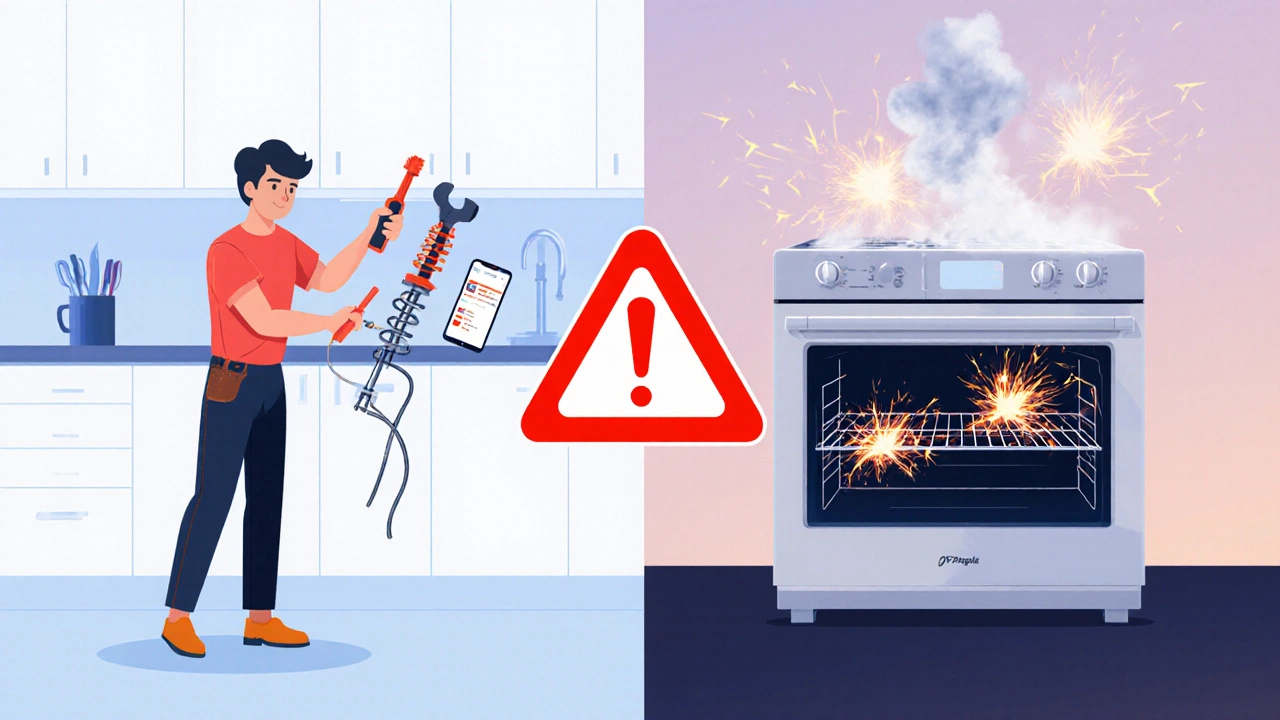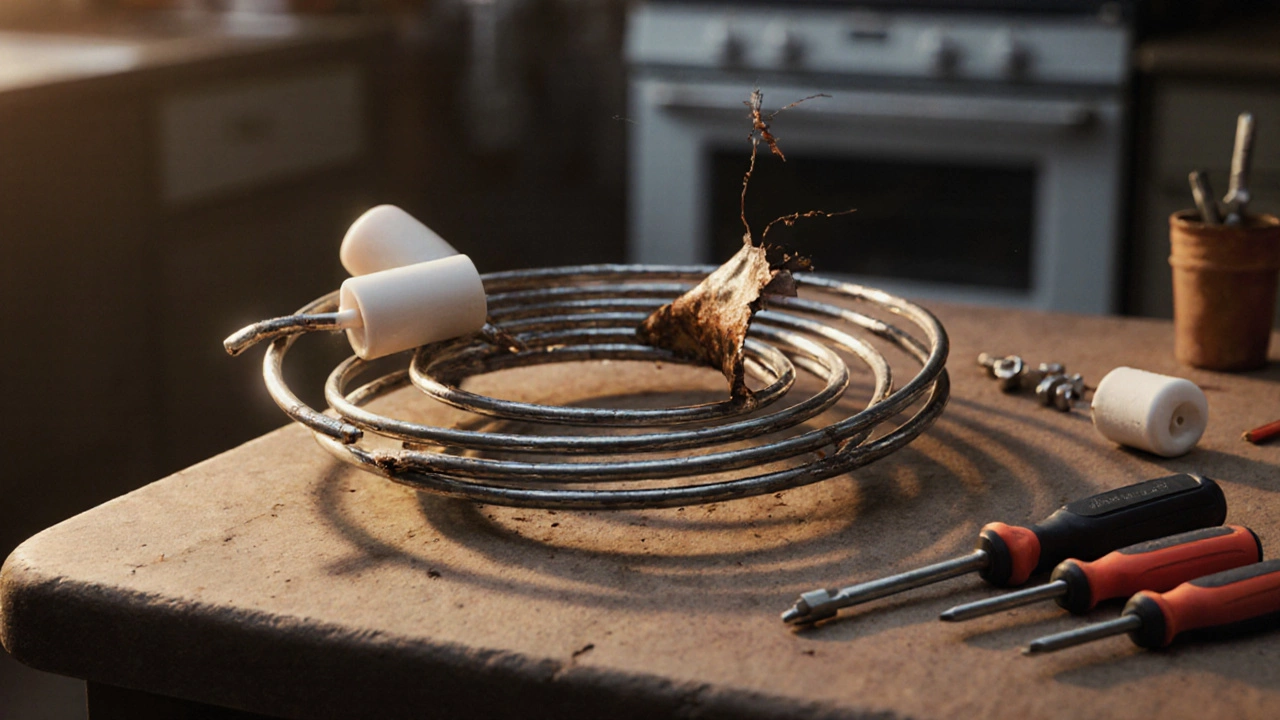Ever opened your oven and found it won’t heat up? Or maybe it takes forever to bake a cake, and the bottom comes out raw while the top burns? Chances are, your heating element has given out. It’s one of the most common oven problems - and one of the easiest to fix. But before you call a technician or order a part, you’re probably wondering: how much does it cost to replace heating element in oven? The answer isn’t one number. It depends on your oven model, where you live, and whether you do it yourself or hire someone.
What a heating element actually does
Your oven has at least two heating elements: one on the bottom for baking, and one on the top for broiling. The bottom element does most of the work. It’s the long, coiled wire you see glowing red when the oven is on. Over time, this element wears out from repeated heating and cooling cycles. Cracks form. The metal fatigues. Eventually, it stops conducting electricity. No glow = no heat.
It’s not a complex part. It’s just a resistive wire inside a metal sheath, held in place by ceramic insulators. You can buy one online for as little as $25. But that’s just the part. The real cost comes from labor - or the time and risk of doing it yourself.
Cost breakdown: parts vs. labor
Let’s break this down into two clear pieces: the part and the service.
Heating element part cost: Between $25 and $70. Budget ovens use cheaper elements that wear out faster. Premium models (like Bosch, Miele, or Wolf) often have higher-quality elements that cost closer to $60-$70. Some ovens have hidden elements behind the back panel - those are usually pricier because they’re harder to manufacture.
Labor cost: $100 to $200 in Australia. Most appliance repair technicians charge $80-$120 per hour. Replacing the element takes 30 to 60 minutes, depending on oven design. If your oven is built into a cabinet or has a hard-to-reach element, expect to pay more. In Adelaide, a typical call-out fee is around $60-$80, then hourly rates apply.
So total cost? Usually between $125 and $270. If you’re lucky and your oven is simple, you might get it done for under $150. If you’ve got a high-end model with a tricky layout, it could hit $300.
DIY: Can you do it yourself?
Yes. And if you’re handy with basic tools, you can save $100-$200 by doing it yourself. It’s not rocket science, but it’s not risk-free either.
You’ll need:
- A new heating element (match the model number exactly)
- A screwdriver (usually Phillips or Torx)
- Pliers (optional, for pulling wires)
- Multi-meter (optional, to test if the element is dead)
Steps are simple:
- Turn off power at the circuit breaker. Never just unplug the oven - it’s hardwired.
- Remove the oven racks and any panels covering the element.
- Unplug the two electrical connectors from the element. Take a photo before you disconnect - wiring can be confusing.
- Unscrew the mounting brackets holding the element in place.
- Slide the old element out, insert the new one, reconnect the wires, screw it back in, and reassemble.
- Turn the power back on and test.
Most people complete this in under 45 minutes. YouTube has dozens of videos for specific oven models. Search for your brand and model + “heating element replacement.”
But here’s the catch: if you mess up the wiring, you could fry the control board. Or if you forget to turn off the power, you could get shocked. One wrong move and your repair bill jumps from $150 to $800.

When to replace vs. when to replace the whole oven
Replacing the element is almost always worth it - unless your oven is older than 15 years. If it’s 10-15 years old and you’ve had other issues (faulty thermostat, broken door seal, sparking control panel), it might be time to upgrade. New ovens are more energy-efficient and come with better warranties.
Here’s a quick rule: if the repair cost is more than half the price of a new oven, consider replacing it. A basic electric oven costs $500-$800. So if your repair quote is over $400, it’s worth shopping for a new one.
Also, check your warranty. Some manufacturers offer 5-10 year parts warranties on heating elements. If yours is still covered, you might get the part free - you’ll just pay for labor.
Where to buy a replacement element
You’ve got three options:
- Manufacturer’s website: Most reliable. You get the exact part. But it’s often the most expensive.
- Online appliance parts stores: Sites like Appliance Parts Pros, eBay, or local Australian sellers like Appliance Parts Australia. Prices are lower, and you can filter by model number.
- Local appliance repair shops: They often sell parts to customers. You can walk in with your oven model and get the right part on the spot.
Always match the part number. Don’t guess. An element that looks similar might not fit or could overheat. The model number is usually on a sticker inside the oven door frame or on the back panel.
What to watch out for
Here are three common mistakes people make:
- Not turning off the power: This is the #1 cause of injury during DIY repairs. Always kill the breaker.
- Buying the wrong element: There are over 500 different oven element types. Match the wattage, length, and connector style.
- Ignoring other issues: If the element burned out, why? Was it due to a faulty thermostat? A damaged wire? A bad control board? If the new element fails again in a few months, you’ve got another problem.
Pro tip: If you’re unsure, take a photo of the old element before removing it. Bring it to a repair shop - they can match it visually.

Real-world example from Adelaide
A friend in Norwood had her 12-year-old Smeg oven stop heating. She called a local technician. The quote: $185 total - $65 for the part, $120 for labor. She got it fixed same day. The oven now works like new. She’s kept it for another 3 years. Total cost: less than $200. A new Smeg oven? Over $1,500. That’s a no-brainer.
Another customer in Prospect tried DIY. Bought a $35 element online. Got the wiring wrong. Burned out the control board. Ended up paying $320 to fix both. Lesson: if you’re not confident, hire a pro.
How long does a heating element last?
Typically 5 to 10 years. But usage matters. If you bake daily, use the self-clean cycle often, or live in a humid climate (like Adelaide’s coastal areas), the element degrades faster. Salt air can corrode connections. High heat cycles stress the metal. That’s why ovens in beachside homes often need element replacements sooner.
Signs your element is dying:
- It doesn’t glow red when the oven is on
- Food takes longer to cook, especially on the bottom
- Uneven baking - one side burns, the other stays raw
- You smell burning or see sparks inside the oven
If you see any of these, don’t wait. A failing element can overheat nearby wiring and become a fire hazard.
Can I use any heating element in my oven?
No. Heating elements are model-specific. They vary in length, wattage, connector type, and mounting style. Using the wrong one can cause overheating, poor performance, or even damage to your oven’s control system. Always match the part number from your old element or your oven’s manual.
How long does it take to replace an oven heating element?
For a professional, it usually takes 30 to 60 minutes. For a DIYer with basic tools and confidence, it can take 45 to 75 minutes. Ovens with hidden elements behind the back panel or built-in models take longer - sometimes up to 90 minutes.
Is it worth repairing an old oven?
Yes, if your oven is under 10 years old and otherwise in good condition. Replacing a heating element costs less than $200 and extends the life of your oven by years. If your oven is 15+ years old and has multiple issues (faulty display, broken door seal, inconsistent temperature), it’s often cheaper to replace it with a new, energy-efficient model.
Do I need to turn off the power before replacing the element?
Absolutely. Ovens are hardwired into your home’s electrical system. Unplugging won’t cut power. You must switch off the circuit breaker that controls the oven. Failure to do this can result in serious electric shock.
Why does my new heating element keep burning out?
If a new element fails quickly, there’s likely another issue. Common causes include a faulty thermostat (causing overheating), damaged wiring, or a failing control board. Have a technician test the thermostat and wiring before installing another element. Replacing the element without fixing the root cause is a waste of money.
Next steps: What to do now
Here’s what to do if your oven isn’t heating:
- Check the circuit breaker - is it tripped?
- Look inside the oven - is the element glowing? If not, it’s likely dead.
- Find your oven’s model number (usually on a sticker inside the door or on the back).
- Search online for that model + “heating element.” Compare prices and reviews.
- Decide: DIY if you’re comfortable, or call a local technician if you’re not sure.
Don’t ignore a broken oven element. It’s not just an inconvenience - it’s a safety risk. Fix it right, and your oven will serve you for years to come.







